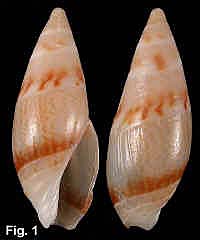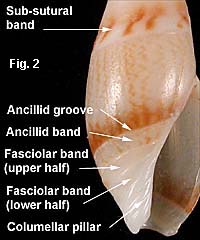

|
Amalda
edithae
(Pritchard & Gabriel, 1898)
Description: Shell slender, aperture one-third to one-half of total shell length.
Spire calloused, callus terminating in front of the aperture;
suture covered by callus. Spire
whorls spirally ribbed, ribs ending at aperture.
Body whorl with calloused subsutural band, edged by a weak
groove. Non-calloused part
of body whorl with microscopic axial and spiral striae.
Columellar pillar with about 5 plaits; fasciolar band with weak
central ridge, upper and lower halves flat and smooth; ancillid band
deeply excavated. Non-calloused
areas of body whorl fawn, with fine axial zigzag brown lines; subsutural
band with oblique brown patches, visible on the spire whorls
as well as body whorl; another spiral brown band above the ancillid
groove; fasciolar band fawn, sometimes with irregular brown streaks;
pillar area white. Operculum
brown, corneous.
Size:
Up to 15 mm in length
Distribution: Endemic to
Australia
;
Newcastle
, NSW, to
Fremantle
,
Western Australia
.
Habitat:
Taken as empty beach shells, and down to 180 metres.
Rare in NSW, more common in southern
Australia
.
Comparison:
In NSW, this species is known from only a few specimens, all
subtidal. It is the most
slender of the genus, with a ribbed spire and two spiral brown bands.
The colouration is similar to A.
oblonga, but that is wider with an inflated body whorl, and has a
smooth spire.
Synonym:
Amalda sydneyensis
Ninomiya, 1991
Figs. 1,2:
Newcastle, NSW (C.166164)
|